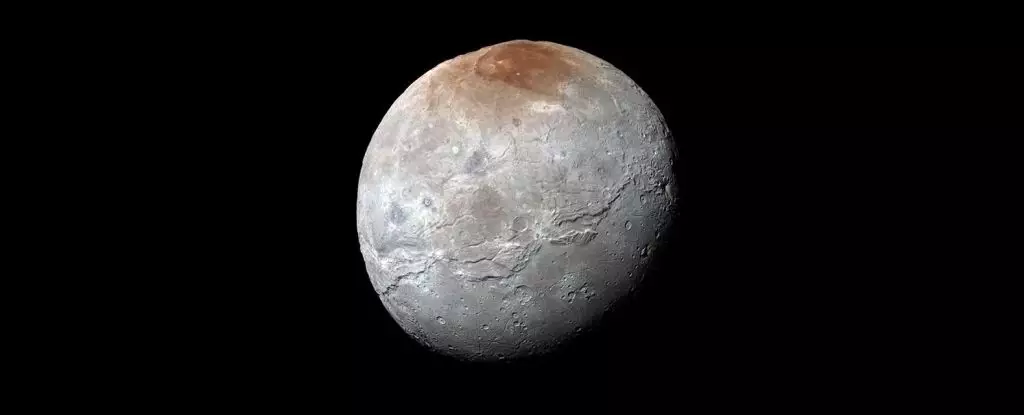Astrobiological discussions often revolve around the path celestial bodies take in the grand theater of space. Among such captivating narratives is the relationship between Pluto and its moon, Charon. Recent research has peeled back layers of this relationship, revealing a collision-based genesis that invites fresh perspectives on planetary formation. This article delves into the implications of this new “kiss and capture” mechanism, contrasting it with conventional theories, while considering the eccentricities of both Pluto and Charon.
For decades, the prevailing wisdom regarding Charon’s origins revolved around the idea of a violent genesis, akin to the great impact that sculpted Earth’s Moon. However, the new study led by planetary scientists at the University of Arizona has introduced a more nuanced understanding, suggesting that instead of a mere impact, Pluto and Charon experienced a fusion-like moment – a “kiss” that allowed for brief conjoinment before separating into their current orbital states. This idea of a more intimate encounter diverges sharply from the “hit-and-run” models typically utilized to describe planetary collisions within our solar system.
The implications of this new model are profound. A collision with a follow-up merging typically results in the debris being flung into space, ultimately creating new celestial bodies. In contrast, this study posits that when Pluto and Charon collided, both bodies maintained their integrity, retaining much of their original forms rather than disintegrating in a violent upheaval. Such a revelation not only shifts our comprehension of their origins but also redefines the parameters regarding how we view similar celestial interactions across the cosmos.
When discussing the characteristics of Pluto and Charon, it’s essential to consider the planetary conditions at play. Measuring 2,376 kilometers across, Pluto draws curiosity due to its idiosyncratic nature. Charon, slightly smaller at 1,214 kilometers, orbits Pluto at a distance of approximately 19,500 kilometers, creating what’s known as a binary system. Unlike warmer celestial bodies, these two are structured primarily of rock and ice, residing far beyond the frost line where water condenses into solid forms.
The low temperatures and solid compositions of Pluto and Charon mean that they reacted differently to their collision than hotter, fluid-like bodies would. Notably, the study draws parallels between Pluto and Charon’s interaction and the contact binary observed in the distant solar object Arrokoth. Herein lies the beauty of the research: it showcases how the unique conditions of Pluto and Charon transcend the one-size-fits-all models typically associated with planetary formation.
One of the standout accomplishments of this study was its ability to mathematically replicate the orbital properties observed in Pluto and Charon’s current configuration. The simulations conducted showed a remarkable alignment with the real-world observations, indicating that the parameters established for their formation are not merely theoretical fantasies but rather grounded in observable reality.
The dual outcomes achieved through simulations – capturing Charon while also aligning it in the proper orbital trajectory – point to a significant breakthrough in planetary science. This newfound clarity also implies that simplistic theories surrounding planetary formation must be reevaluated. Researchers can now apply this understanding to other celestial bodies, enhancing astronomers’ ability to understand complex formation histories.
The unfolding story of Pluto and Charon, with its unique “kiss and capture” paradigm, serves as a microcosm for broader explorations into the nature of celestial mechanics. By acknowledging the distinctions in material composition and the behaviors of different types of celestial bodies, scientists can glean insights into not only the origins of Pluto and Charon but also the mechanisms that govern the birth and evolution of other planetary systems in the universe.
This newfound knowledge fuels a greater understanding of geological evolution, particularly for bodies like Pluto, which possess unique characteristics that set them apart from other planets in our solar system. The questions posed by this research extend beyond the immediacy of origins: how does this initial configuration sculpt Pluto’s geological history over time? Each layer of inquiry only adds to the allure of exploring a world that continues to defy expectations.
The study of Pluto and Charon has ushered in a refreshing perspective on celestial dynamics, presenting a case for considering the particulars of material properties in planetary formation theories. As research progresses, it will likely continue to reveal the magic embedded in the cosmos, challenging researchers at every turn to rethink everything they thought they understood about planetary systems.

